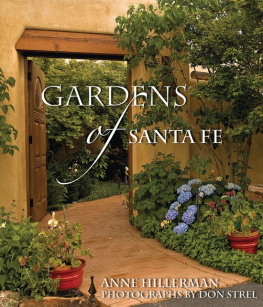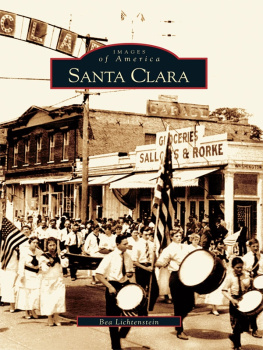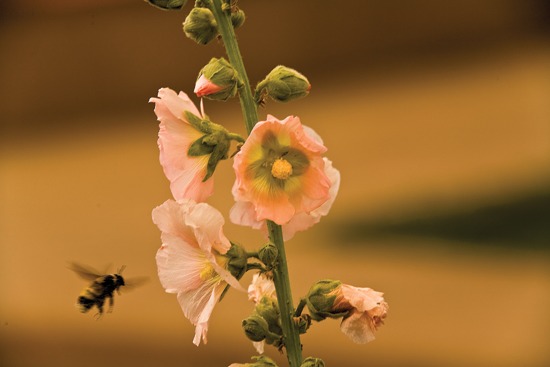All rights reserved. No part of this book may be reproduced by any means whatsoever without written permission from the publisher, except brief portions quoted for purpose of review.
1. GardensNew MexicoSanta FePictorial works. I. Strel, Don. II. Title.
Acknowledgments
This book would not have been possible without the generosity of the Santa Fe gardeners featured here, among them former strangers who opened their gates and hearts to us. I appreciated the help of many people with substantial knowledge about gardening and would especially like to thank Jan Barbo, Bob Ross, Sarah McCarty, Enid Tidwell, Linda Milbourne at the Santa Fe Botanic Garden, Gretchen Rau, and Edwina Milner for all the good ideas, suggestions, and referrals they shared with me.
My deep appreciation to Cindy Bellinger, my long-time writing buddy, for her insightful editing, and to Jann Arrington Wolcott and Rebecca Carrier Smith, both fine writers and thoughtful critics. I am indebted to Ellen Kleiner for recommending this project to me. Thanks also to garden photographer Charles Mann for his advice on the project early on and to editor Michelle Witte for her help with the book.
Finally, without photographer Don Strel, this book would only be words. We had a wonderful time working together. Thanks, Don, for such beautiful pictures.
Anne Hillerman
Working with Anne Hillerman was a joy. We had many discussions and made some very hard decisions, focused on how to best present the wonderful gardens of Santa Fe. We shared numerous adventures discovering new gardens and new approaches to writing and taking pictures of them. I must say it was a visual feast.
My thanks to Anita Quintana, Tom Berner, and Mac Read for their advice and good nature. Also I must thank the many gardeners whose creativity was a pleasure to experience.
Don Strel
The Adventure of Santa Fe Gardens
Gardening in Santa Fe is not for sissies, nor for the faint of heart. Creating a garden in Santa Fes arid, breathtaking landscape often demands the muscle to turn clay and caliche into soil with a million shovels full of compost. It requires fortitude when a twenty-minute hailstorm transforms a summers worth of blossoms into confetti. It demands persistence to discover plants that can withstand dry hot summers, freezing snowy winters, and the other challenges of a southerly 7,000-foot elevation. Santa Fe gardens reward hard work that meshes good luck with vibrancy more cherished because of its transience.
This book is as much about Santa Fe gardeners as it is their gardens.
I visited more than fifty gardens in 2007, looking for successful hands-on gardeners who approached the task with soul-felt passion. I talked to people in their eighties and those who could have been their grandchildren. They all shared the same sense of wonder at the diversity, resilience, and beauty created by the interaction of soil, roots, water, sunlight, nature, and human hands. Gardeners here are a spunky, eclectic, smart, generous, and varied lot, and I am in their debt.
Most gardens I visited nurtured memories as well as flowers. I saw scores of plants transplanted from gardens elsewhere and many that arrived as gifts from friends and family. I heard stories of a suitcase of violets flown home from California and maple trees that came in a moving van. I saw plum trees grown from seeds accidentally brought from Asia and a gnarled old apricot started from a pit stuck in a pocket during a trip to India. I admired daylilies dug from an abandoned pioneer home site and pussy willows cultivated from house-warming bouquets.
It wasnt all pretty. Gardeners showed me piles of disintegrating compost, handfuls of wriggling earthworms, and hills of smelly manure, describing it all in words close to poetry. In one patio, I noticed a grand old wisteria with branches as thick as a three-year-olds forearm. Then one of the branches began to move. I froze. A slender oblong head and two intensely dark eyes emerged. I watched as the glossy, graceful black-tailed rattlesnake, six-feet long and the color of caf latte, climbed to a place where it could better watch me. It sniffed the air with its black flickering tongue and silently moved deeper into the vine. Who was the more surprised? Later, I noticed an empty birds nest in the same gnarled vine.
The gardeners all welcomed birdssome with elaborate feeders and birdbathsbut they were of different minds on dogs. Many, however, had at least one canine with free rein of the gardens. I met a golden retriever that loved to dig holes, a hound that raided the bird feeders, and fuzzy poodles that licked my toes. Miniature dogs patrolled patios in search of invading animals and visitor attention. One gardener invited me to join him on the patio couch. As we chatted, his miniature dachshunds grew amorous. First the female and then her eager suitor jumped up on the couch next to me. The gardener talked on, oblivious to the wild wiener-dog passion, and I managed to keep taking notes. But of course, gardens in their essence are all about sexas well as life, death, and water.
Water conservation is a critical issue in Santa Fe. During droughts, the city restricts water for gardens. I visited one elegant home that had a koi pond in the front and several courtyard fountains running with recycled water. The serenade of gentle tinkling led photographer Don Strel to ask the homeowner if he could use her bathroom. She paused, and then excused herself. We heard splashing behind the closed bathroom door, and she emerged with a plastic bucket. She walked to the large rain barrel in the patio and filled the bucket halfway. She presented it to Don as if it were the Oscar. Use this to flush, she smiled. Were careful with water around here.
Tending a garden helps us grow comfortable with beginnings and endings, with the fragility of new life and the inevitability of death. More than one gardener who had come from a milder climate told me how she cried the first fall morning when she discovered that all her tender plants had died.
One, when asked why she gardened, quoted from A Patchwork Garden, by Sydney Eddison. It sums up what I discovered as I wrote this book:
Being a gardener means being part scientist and part artist. It means being as strong as an ox and as tough as old boots. It means being impervious to insect bites, rain, sleet, snow, heat, sunburn and sunstroke. It means reading and learning; lifting and digging. It means knowing what you want to achieve and why. It means being nimble-fingered enough to prick out seedlings and heavy-handed enough to break rocks with a sledgehammer. It means blood, sweat and tears. And it means ecstasy.
The people whose gardens I have featured here inspired me with their ebullience and optimism. I hope their stories do the same for you.















